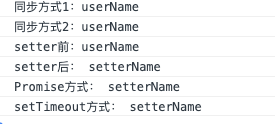简介
在 vue 的官方文档中有一个 API 叫做 nextTick,将回调延迟到下次 DOM 更新循环之后执行。在修改数据之后立即使用这个方法,获取更新后的 DOM。
语法
1 | vm.$nextTick([callback]); |
- 参数:
1 | { |
用法
放在Vue.nextTick()回调函数中的执行的应该是涉及 DOM操作的 JavaScript 代码。
Vue 的响应式原理:在 data 选项里所有属性都会被watcher监控,当修改了data的某一个值,并不会立即反映到视图中。Vue 会将我们对data的更改放到watcher的一个队列中(异步),只有在当前任务空闲时才会去执行watcher队列任务。这就有一个延迟时间,所以对 dom 的操作要放在$nextTick中来操作,才能获取到最新的dom。
nextTick 是 Vue 的一个核心实现,如果还不了解 js 运行机制,可以看一下另一篇文章js 运行机制,这里就不多赘述了。
在浏览器环境中常见的 macro task 和 micro task 如下:
macro task:
setTimeout、setTimeIntervalMessageChannelpostMessagesetImmediaterequestAnimationFrameI/OUI 渲染a
micro task:
- MutationObsever
- Promise.then
- process.nextTick
vue 源码解析
在派发更新 Watcher里面有用到nextTick(flushScheduerQueue),其实就是vue对派发更新的一个优化。下面直接看源码,在 src/core/util/next-tick.js 中:
1 | // nextTick 中执行回调函数的原因是保证在同一个 tick 内多次执行 nextTick,不会开启多个异步任务,而把这些异步任务都压成一个同步任务,在下一个 tick 执行完毕。 |
nextTick这就是我们在上一节执行 nextTick(flushSchedulerQueue) 所用到的函数。它的逻辑也很简单,把传入的回调函数 cb 压入 callbacks 数组,最后一次性地根据 useMacroTask 条件执行 macroTimerFunc 或者是 microTimerFunc,而它们都会在下一个 tick 执行 flushCallbacks。flushCallbacks 这个方法就是挨个同步的去执行callbacks中的回调函数,callbacks中的回调函数是在调用 nextTick 的时候添加进去的;
这里使用 callbacks 而不是直接在 nextTick 中执行回调函数的原因是保证在同一个 tick 内多次执行 nextTick,不会开启多个异步任务,而把这些异步任务都压成一个同步任务,在下一个 tick 执行完毕。
注意这里有个比较难理解的地方,第一次调用 nextTick 的时候 pending 为false。
此时已经push到浏览器event loop中一个宏任务或微任务的task,如果在没有flush掉的情况下继续往callbacks里面添加。
那么在执行这个占位queue的时候会执行之后添加的回调,所以macroTimerFunc、microTimerFunc 相当于task queue的占位。
以后 pending 为true则继续往占位queue里面添加,event loop轮到这个task queue的时候将一并执行。
执行 flushCallbacks 时 pending 置false,允许下一轮执行 nextTick 时往event loop占位。
macroTimerFunc、microTimerFuncnext-tick.js 申明了 microTimerFunc 和 macroTimerFunc 2 个变量,它们分别对应的是 micro task 的函数和 macro task 的函数。对于 macro task 的实现,优先检测是否支持原生 setImmediate,这是一个高版本 IE 和 Edge才支持的特性,不支持的话再去检测是否支持原生的 MessageChannel,如果也不支持的话就会降级为 setTimeout 0;而对于 micro task 的实现,则检测浏览器是否原生支持 Promise,不支持的话直接指向 macro task 的实现。
nextTick 实现
- 首先
nextTick把传入的cb回调函数用try-catch包裹后放在一个匿名函数中推入callbacks数组中。
这么做是因为防止单个cb如果执行错误不至于让整个JS 线程挂掉。
每个 cb 都包裹是防止这些回调函数如果执行错误不会相互影响,比如前一个抛错了后一个仍然可以执行。 - 然后检查
pending状态,这个跟之前介绍的queueWatcher中的waiting是一个意思。
它是一个标记位,一开始是false在进入macroTimerFunc、microTimerFunc方法前被置为true。因此下次调用nextTick就不会进入macroTimerFunc、microTimerFunc方法。
这两个方法中会在下一个macro/micro tick时候flushCallbacks异步的去执行callbacks队列中收集的任务,而flushCallbacks方法在执行一开始会把pending置false。
因此下一次调用nextTick时候又能开启新一轮的macroTimerFunc、microTimerFunc,这样就形成了 vue 中的event loop。 - 最后检查是否传入了
cb。因为nextTick还支持 Promise 化的调用:nextTick().then(() => {})。所以如果没有传入cb就直接return了一个Promise实例,并且把resolve传递给_resolve。这样后者执行的时候就跳到我们调用的时候传递进 then 的方法中。
示例
代码如下:
1 | <template> |
执行结果如下图所示:
- 同步方式: 当把
data中的name修改之后,此时会触发name的setter中的dep.notify通知依赖本data的render watcher去update,update会把flushSchedulerQueue函数传递给nextTick,render watcher在flushSchedulerQueue函数运行时watcher.run再走diff -> patch那一套重渲染re-render视图,这个过程中会重新依赖收集,这个过程是异步的;所以当我们直接修改了name之后打印,这时异步的改动还没有被patch到视图上,所以获取视图上的 DOM 元素还是原来的内容。 - setter 前:
setter前为什么还打印原来的是原来内容呢,是因为nextTick在被调用的时候把回调挨个push进callbacks数组,之后执行的时候也是 for 循环出来挨个执行,所以是类似于队列这样一个概念,先入先出;在修改name之后,触发把render watcher填入schedulerQueue队列并把他的执行函数flushSchedulerQueue传递给nextTick,此时callbacks队列中已经有了setter前函数 了,因为这个cb是在setter前函数 之后被push进callbacks队列的,那么先入先出的执行callbacks中回调的时候先执行setter前函数,这时并未执行render watcher的watcher.run,所以打印 DOM 元素仍然是原来的内容。 - setter 后:
setter后这时已经执行完flushSchedulerQueue,这时render watcher已经把改动patch到视图上,所以此时获取 DOM 是改过之后的内容。 - Promise 方式: 相当于
Promise.then的方式执行这个函数,此时 DOM 已经更改。 - setTimeout 方式: 最后执行
macro task的任务,此时 DOM 已经更改。
注意,在执行 setter前函数 这个异步任务之前,同步的代码已经执行完毕。异步的任务都还未执行,所有的 $nextTick 函数也执行完毕。所有回调都被push进了callbacks队列中等待执行,所以在setter前函数执行的时候。此时callbacks队列是这样的:
1 | [setter前函数, flushSchedulerQueue, setter后函数, Promise方式函数]; |
它是一个micro task队列,执行完毕之后执行macro task setTimeout,所以打印出上面的结果。
总结
nextTick是把要执行的任务推入到一个队列中,在下一个tick同步执行- 数据改变后触发渲染
watcher的update,但是watchers的flush是在nextTick后,所以重新渲染是异步的